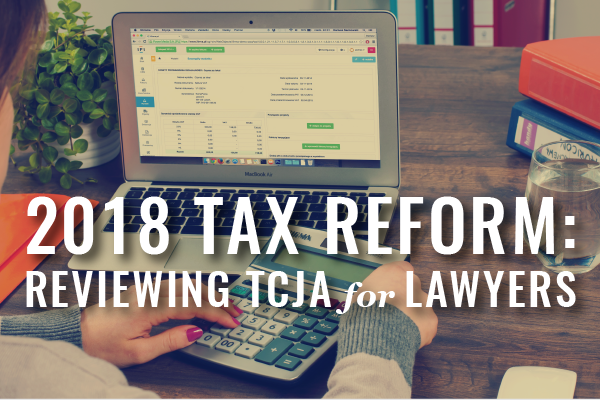Tax reform made effective January 1, 2018 brought big changes to the system. Find out how your work and income as a lawyer fits with these provisions until they expire in 2025.
We thank Brad M. Capland, CPA for writing and contributing the following post. Brad is a Certified Public Accountant and a Registered Representative (series 7 and 66 license) affiliated with Integrated Financial Services. Brad’s CPA firm focuses on helping small to medium sized privately owned service related businesses become more profitable and efficient, handling all of their financial accounting, tax, and bookkeeping needs. With over 25 years of practical experience in all areas of tax planning and tax return preparation for individual taxpayers and small businesses, Brad has expertise in IRS and State Income Tax Audits, and also specializes in M&A work, business exit planning, and general business consulting and accounting-related services. He is a member of the American Institute of Certified Public Accountants and the Massachusetts Society of Certified Public Accountants, and has owned his CPA firm in West Concord since 1991. He lives in Acton with his spouse, three children, and Golden Doodle. He enjoys skiing and tennis. Brad’s website is bradcapland.com, and you can email him at brad@bradcapland.com
. . .
The Tax Cuts and Jobs Act of 2017 (The TCJA, “The Act”) was enacted December 22, 2017 and became effective January 1, 2018 — and is a massive tax change to the federal tax system. It dramatically impacts our federal tax law for all Individuals, Corporations and Pass- Through Entities. The TCJA comprises over 750 pages of tax reform. This article discusses a few of the changes that are relevant to attorneys and related clients. For planning purposes keep in mind all of the provisions in the TCJA are only applicable for 7 years and are schedule to expire December 31, 2025, unless extended.
This article will review the following:
- The Pass-Through Business Income Deduction for Attorneys
- Deduction Impacts on Law Firm Clients
- Standard Deductions vs Itemized Deduction
- Updates on Mortgage Interest, Taxes, and Alimony Deductions
- Tax Planning
1. THE PASS-THROUGH BUSINESS INCOME DEDUCTION
Massachusetts has not adopted this provision. The Pass-Through Business Income Deduction provision remains a federal exclusion only.
The TCJA made changes to corporate tax rates. Before the TCJA took effect, C Corporations, other than Personal Service Corporations (PSC), tax rates ranged from 15% to 35%. PSCs were taxed at a flat 35%. The TCJA reduced both of those corporate tax rates to a flat 21%! The dreaded PSC “penalty” is now effectively gone, at least until 2026 arrives. Overall corporate tax rates have been reduced by 40%!
To level the playing field for “non-corporate” taxpayers, TCJA modified the Internal Revenue Code (Section 199A) to allow a 20% reduction for “Pass-Through Entities”. Before the TCJA took effect, individual tax rates maxed out at 39.6%. The TCJA reduced the top rate to 37%, plus a further reduction when utilizing the 20% deduction on Pass-Through Entities. Accordingly, the effective rate becomes 29.6% — or a 25% reduction.
Calculating who gets this 20% deduction, and when, is complicated. We need to understand some basic definitions to review code section 199A.
- Qualified Business Income (QBI). Pass-Through profits after wages and guaranteed payments.
- Specified Service Trade and Business. Essentially, service related businesses, including attorneys, but excluding engineering firms, architectural firms, investment type activity firms and real estate developers, as per IRC 1202(e)(3)(a).
- Phase In and Phase Out. Point at which the 20% deduction starts to get phased out.
- Taxable Income (TI). Individual (Form 1040) taxable income.
The general rule is EVERYONE who has taxable income less than $315,000 (if married) and $157,500 (if single) is entitled to the 20% deduction based on the QBI. Example: If you’re a lawyer and own a law practice (S Corp, Schedule C, LLP or LLC) and have $100,000 of profit (QBI), then you only pay federal tax on $80,000. If subject to Self- Employment tax, that rate would be calculated on the entire $100,00 amount.
When your taxable income exceeds $315,000 (if married) or $157,500 (if single), calculating who gets this 20% deduction, and how much, is more difficult. Attorneys, CPAs, and other service businesses where the business is based on on owner/employee skills are classified as Specified Service Trade and Businesses. If you are in that type of business, once your TI exceeds $415,000 (if married) of $207,500 (if single) you are “Phased Out” of the 20% deduction. Between the $315,000 to $415,000 TI amounts (if married) and between $157,500 to $207,500 (if single) you are in the “Phase In to Phase Out” area. In the Phase In to Phase Out range, you start to lose the ability of using the 20% deduction at the lower range and completely lose it at the upper range.
Example for Specified Service Trade and Business:
- Single taxpayer with TI of $200,000 — included in this number is Schedule C profit of $100,000 which includes $90,000 of wage expenses.
- QBI deduction is the lesser of (a) or (b): (a) 20% of QBI or $20,000. (b) Wages times 50% or $45,000.
- The lesser amount is $20,000, BUT the taxpayer is in the Phase In Phase Out area, therefore that amount must be reduced as follows: TI of $200,000 – $157,500 = $42,500 / $50,000 (Phase In to Phase Out range) = 85%.
- Therefore, the deductible QBI amount is reduced by 85% and the taxpayer can only deduct 15% (100% – 85%) of the $20,000 or $3,000.
- Further: Zero deduction applies when TI exceeds $207,500.
There are many other complex calculations to involved for businesses that are not classified as Specified Service Trade and Businesses when calculating the 20% QBI deduction. For detailed information, check out Tax Geek Tuesday: Making Sense Of The New ‘20% Qualified Business Income Deduction.
2. DEDUCTION IMPACTS LAW FIRM CLIENTS
Two big deductions questions here: (1) Are legal fees still deductible? (2) Are professional fees deductible? When it comes to taxes clear Yes or No answers are rare. The answers to these questions depend on the following:
- If you are taxed as a corporation, fiduciary or as a pass-through entity the general answer is YES provided they are valid expenses.
- If you are taxed as an individual (and not a schedule C), the answer is NO. Most of the “miscellaneous itemized deductions” which used to be subject to a 2% deductibility reduction, are eliminated. For example, tax prep fees, investment advisory fees, investment related fees and legal and estate planning fees are NO LONGER tax deductible. Additionally, no deduction is allowed for any settlement, payout or attorney fees related to sexual abuse if such payments are subject to a nondisclosure agreement.
3. STANDARD DEDUCTION v ITEMIZED DEDUCTION
Can we still itemize and can still deduct . . . ?
- Medical expenses: YES
- Taxes: YES
- Interest: YES
- Contributions: YES
- Miscellaneous deductions: NO
There are significant limitations on what can be deducted and deductible amounts have been reduced. Personal exemptions have also been eliminated. Major changes effectively eliminated the deduction for all miscellaneous itemized deductions. However, the standard deduction for married people doubled and is now $24,000, $12,000 if single and $18,000 for head of household. It’s possible that many people will claim the standard deduction and not itemize.
4. UPDATES ON MORTGAGE INTEREST, TAXES, AND ALIMONY DEDUCTIONS
There were major changes to the following three deductions: (1) Mortgage Interest, (2) Taxes, and (3) Alimony.
MORTGAGE INTEREST is still deductible BUT: If mortgage was outstanding as of 12/17/17 (or purchase contract was dated before 12/16/17) then it is grandfathered. Under this situation, if married, you can deduct interest on mortgages used for first and/or second homes up to $1,000,000 and up to $100,000 of HELOC mortgages. If you are single, you can only deduct interest on first $500,000. Interest on refinanced mortgages are generally allowed. However, if mortgage was taken out AFTER 12/17/17, you can ONLY DEDUCT interest on mortgages up to $750,000 (for married), one half that amount if single. Interest on HELOC is no longer deductible.
TAXES are are still deductible BUT are limited to a $10,000 deduction if married or $5,000 if single or if married filing separately.
ALIMONY needs a closer look. Historically alimony payments were never an “itemized deduction” but rather an adjustment to arrive at adjusted gross income. The recipient reported the alimony as income. Under TCJA, significant changes impact divorce agreements or separation instruments entered into after 2018. If a divorce agreement, entered into before 12/31/18, is modified after 2018, and the modification expressly provides that the amendment made by this section apply then the modification will be impacted by the new tax law and, in that situation, the alimony payments will no longer be deductible nor will the income be taxable.
5. TAX PLANNING
As of now there seems to be a loophole in the law that could allow an attorney – or someone else in the service sector – to set up an LLC, rather than an S Corporation and convert wages into QBI, assuming they are below the phase amounts. By doing this the entire QBI would be eligible for the 20% deduction! Eventually the IRS could close this loophole by establishing a “reasonable compensation” standard for LLC’s or LLP’s similar to the S Corp standard, which would reduce or close this loophole.
Tax planning opportunities exist to reduce taxable income to utilize the 20% QBI deduction. One strategy is to consider maximizing SEP and/or solo 401K contributions. Another is to use accelerated depreciation. All in an attempt to reduce taxable income!
Business entity planning is more complex under the new law. For example, it “may” make sense to be a C Corp vs another type of tax entity. Each situation is unique and any determination should incorporate a variety of factors such as exit strategy.
Related Resource:
Understanding What the 2017 Tax Reform Act Means for Your Law Firm (Slides)




